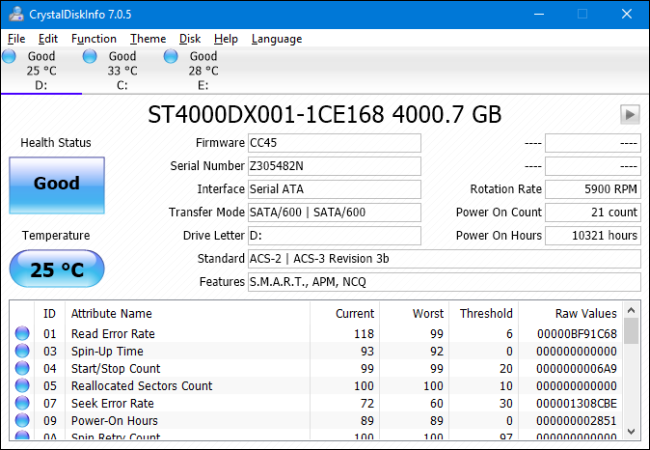
Check S.M.A.R.T. Status with CrystalDiskInfo
CrystalDiskInfo (free) is an easy-to-use, open-source program that can shows the S.M.A.R.T. status details reported by your hard drives. You can download an installable or portable version—the choice is up to you.
Once you’ve got CrystalDiskInfo running, it’s a pretty straightforward app. The main view shows the S.M.A.R.T. status information for your hard drives. If everything is working properly, you should see the status “Good“ displayed. In the image below, just under the menu bar, you can see that all three drives in our system report a “Good” status and you can even view the temperature of each drive. Other statuses you might see include “Bad” (which usually indicates a drive that’s dead or near death), “Caution” (which indicates a drive that you should most likely be thinking about backing up and replacing), and “Unknown” (which just means that S.M.A.R.T. information could not be obtained).

You can also view a list of detailed information about each drive, but unless you’re a pro—or you’re troubleshooting something very specific—it likely won’t mean much to you. If you’re interested, though, the Wikipedia page for S.M.A.R.T. maintains a pretty good list of these attributes, along with how they can be interpreted.
There’s really not a lot more to the app, but there is one other feature worth pointing out. If you are particularly concerned about the health of a drive, you can set CrystalDiskInfo to start with Windows and run as a background app. While it’s running this way, CrystalDiskInfo will send a notification to alert you if the S.M.A.R.T. status of any drive changes. Just open the “Function” menu and toggle both the “Resident” and “Startup” options on.

Check S.M.A.R.T. Status at the Command Prompt
You can also view a very basic S.M.A.R.T. status from the Windows Command Prompt. To open the Command Prompt, hit Start, type “Command Prompt,” and then press Enter.

A the prompt, type (or copy and paste) the following command, and then press Enter:
wmic diskdrive get status

If everything is working properly, you should see the status “OK” displayed for each hard drive on your system. Other statuses—such as “Bad,” “Caution,” or “Unknown”—can indicate problems with your drive or errors retrieving S.M.A.R.T. information.
Help, My Hard Drive Is Dying!
If the S.M.A.R.T. status indicates that you have an error, it does not necessarily mean that your hard drive is going to fail immediately. However, if there’s a S.M.A.R.T. error, it would be wise to assume that your hard drive is in the process of failing. A complete failure could come in a few minutes, a few months, or—in some cases—even a few years. However long it takes, you should not trust the hard drive with your data in the meantime.

No comments:
Post a Comment